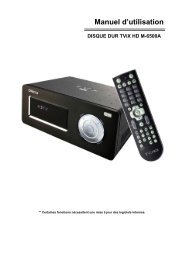MECABLITZ 50 AF-1 digital - Materiel.net
MECABLITZ 50 AF-1 digital - Materiel.net
MECABLITZ 50 AF-1 digital - Materiel.net
Create successful ePaper yourself
Turn your PDF publications into a flip-book with our unique Google optimized e-Paper software.
5 Information in Display<br />
The Nikon cameras of the Groups B, C, D und E (see Table 1) transmit the settings<br />
for ISO, lens focal length (mm) and aperture to the flash unit. It calculates<br />
the maximum flash range from the settings and their guide number. Flash mode,<br />
range, aperture and zoom position of the main reflector are displayed in the<br />
display of the flash unit.<br />
If the flash unit is operated without having received data from the camera (for<br />
example, if the camera is switched off or with a camera from Group A), only<br />
the flash mode selected, the zoom position of the main reflector and „Zoom“ is<br />
displayed. The displays for aperture and range only occur once the flash unit<br />
has received the data required from the camera.<br />
☞ Displays for aperture and range only occur with cameras from Groups B,<br />
C, D & E (see Table 1) if these are operated with an <strong>AF</strong> lens or a lens with<br />
CPU !<br />
Display illumination<br />
Every time a button on the flash unit is pressed, the flash display illumination is<br />
activated for 10 seconds. When a flash is fired via the camera or the hand<br />
release � on the flash unit, the display illumination is switched off.<br />
5.1 Display of the flash mode<br />
TTL<br />
TTL<br />
F 5,6<br />
7,5 m Zoom 105 mm<br />
The flash mode set appears in the display.<br />
Depending on the camera model or camera<br />
group (see Table 1), different displays are<br />
possible in this connection for the various<br />
TTL flash modes supported (for example,<br />
TTL , TTL BL, TTL , TTL BL) and the<br />
manual flash mode M, see 7).<br />
5.2 Range display<br />
When using cameras from Groups B, C, D and E and a lens with CPU, the range<br />
is indicated in the display. For this a data exchange must have occurred between<br />
the camera and flash unit, for example by tapping the shutter release.<br />
The range can be displayed either in metres (m) or feet (ft) - see 9.7.<br />
☞ There is no range display with cameras from Group A, or<br />
- when using lenses without CPU (e.g. manual focus lens).<br />
- when the reflector head is tilted out of its normal position (upwards,<br />
downwards or sideways).<br />
- the flash unit is working in remote flash operation (slave SL).<br />
Range display in TTL flash modes<br />
In the TTL flash modes ( TTL , TTL BL, TTL , 7,5 m<br />
TTL<br />
TTL BL; see 7.1) the value for the maximum<br />
range of the flash unit is displayed. The value indicated<br />
relates to subjects with a reflection factor of 25%,<br />
which applies to most photographic situations. Strong<br />
deviations from this reflection factor, as in the case of<br />
F 5,6<br />
7,5 m Zoom 105 mm<br />
✴<br />
highly reflective or poorly reflective subjects, may affect the flash range of the<br />
flash unit.<br />
The subject ought to be in the area of approximately 40% to 70% of the value<br />
displayed. This will give the automatic exposure control sufficient scope for compensation.<br />
To avoid overexposure, the minimum distance should be no less than<br />
10% of the indicated value! Adjustment to the photographic situation at hand<br />
can be achieved by, for example, changing the aperture of the setting on the<br />
lens.<br />
93<br />
�





